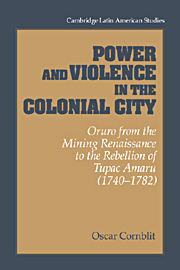 Power and Violence in the Colonial City
Power and Violence in the Colonial City Book contents
- Frontmatter
- Contents
- List of figure, maps, and tables
- Preface
- Map 1 Present-day Bolivia and surrounds
- Map 2 Principal routes of the Viceroyalty of Peru (second half of the eighteenth century)
- 1 Oruro between two epochs: a mining cycle
- 2 Under Spanish law
- 3 Oruro in 1741: details of a stormy election
- 4 The people
- 5 “Madmen, comedians, and hypocrites”
- 6 Captains of shipwreck
- 7 Returning to the known
- 8 “The fruits of the earth”
- 9 The end of an epoch: the Indian uprisings of 1780–1781
- 10 Oruro in the economic and geopolitical context of the epoch (c. 1780–1781)
- 11 The Oruro uprising
- 12 The voice of the rebels
- 13 Picking up the pieces
- Appendix A Indian raids on Oruro, 1781: testimonies
- Appendix B Testimonies of inhabitants of the city
- Appendix C Table of public jobs in Oruro, 1730–1784
- Bibliography
- Index
- CAMBRIDGE LATIN AMERICAN STUDIES
12 - The voice of the rebels
Published online by Cambridge University Press: 30 March 2010
- Frontmatter
- Contents
- List of figure, maps, and tables
- Preface
- Map 1 Present-day Bolivia and surrounds
- Map 2 Principal routes of the Viceroyalty of Peru (second half of the eighteenth century)
- 1 Oruro between two epochs: a mining cycle
- 2 Under Spanish law
- 3 Oruro in 1741: details of a stormy election
- 4 The people
- 5 “Madmen, comedians, and hypocrites”
- 6 Captains of shipwreck
- 7 Returning to the known
- 8 “The fruits of the earth”
- 9 The end of an epoch: the Indian uprisings of 1780–1781
- 10 Oruro in the economic and geopolitical context of the epoch (c. 1780–1781)
- 11 The Oruro uprising
- 12 The voice of the rebels
- 13 Picking up the pieces
- Appendix A Indian raids on Oruro, 1781: testimonies
- Appendix B Testimonies of inhabitants of the city
- Appendix C Table of public jobs in Oruro, 1730–1784
- Bibliography
- Index
- CAMBRIDGE LATIN AMERICAN STUDIES
Summary
As we might expect, none of the invading Indians left voluntary written testimony about the uprising. Fortunately for historical reconstruction, the trials held after the revolt produced detailed accounts in which the Indians being prosecuted expressed, in some cases with astonishing candor and bluntness, their motivations for joining the movement. Furthermore, letters and written orders exchanged by the Indian chiefs, and those sent between them and their subordinates, reveal the expectations of the movement's leaders. From these sources it is possible to follow the thread of the insurrections of March and April 1781 that followed the February invasion.
The eviction of the Indians from Oruro, accomplished after the difficult negotiations that have been recounted, did not put an end to their aspirations, as the Creoles and European Spaniards had naively hoped.
All February, March, and April insurrections were finally broken up, and this probably owed less to the royalist forces than to the lack of coordination among the Indians. As in other areas, the perception of defeat spread among the rebel Indians with the same speed as had the call to revolt. The Indians of the community surrendered en masse as soon as they knew of the defeat of their advance guard by the army sent to put the rebellion down. In most cases, the chieftains were not taken prisoner; rather, they were handed over by the Indians themselves.
In spite of the escriban's monotonous transcription – in most cases accomplished with the aid of a translator – it is not difficult to imagine the pathetic character of these scenes.
- Type
- Chapter
- Information
- Power and Violence in the Colonial CityOruro from the Mining Renaissance to the Rebellion of Tupac Amaru (1740–1782), pp. 161 - 166Publisher: Cambridge University PressPrint publication year: 1995


